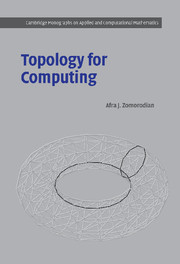1 - Introduction
Published online by Cambridge University Press: 19 August 2009
Summary
The focus of this book is capturing and understanding the topological properties of spaces. To do so, we use methods derived from exploring the relationship between geometry and topology. In this chapter, I will motivate this approach by explaining what spaces are, how they arise in many fields of inquiry, and why we are interested in their properties. I will then introduce new theoretical methods for rigorously analyzing topologies of spaces. These methods are grounded in homology and Morse theory, and generalize to high-dimensional spaces. In addition, the methods are robust and fast, and therefore practical from a computational point of view. Having introduced the methods, I end this chapter by discussing the organization of the rest of the book.
Spaces
Let us begin with a discussion of spaces. A space is a set of points as shown in Figure 1.1(a). We cannot define what a set is, other than accepting it as a primitive notion. Intuitively, we think of a set as a collection or conglomeration of objects. In the case of a space, these objects are points, yet another primitive notion in mathematics. The concept of a space is too weak to be interesting, as it lacks structure.
- Type
- Chapter
- Information
- Topology for Computing , pp. 1 - 10Publisher: Cambridge University PressPrint publication year: 2005



